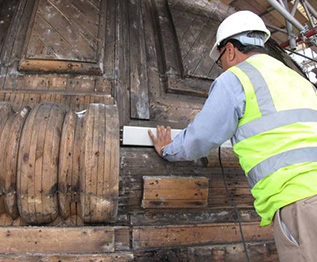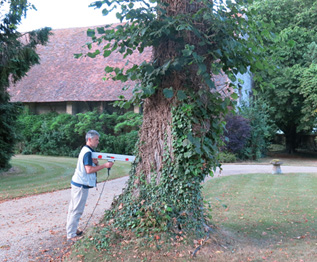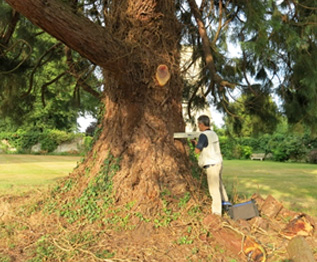Identifying and solving building problems environmentally without the use of chemicals
+44 (0) 1908 266522
Timber Decay Survey
Resistograph: Non-Destructive Testing
for Timber Decay


Dr. Jagjit Singh using the Resistograph

Timber Pathologist, Huw Lloyd using the Resistograph to test a Lime tree in a Manor House in Northamptonshire

The Resistograph being used to test a Giant Redwood tree in Northamptonshire
Non-destructive inspection techniques enable the condition of timbers to be ascertained without destroying the fabric of the building. They are especially valuable in buildings of historic and architectural interest.
A Resistograph is an advanced detection device with the ability to determine the exact location and type of decay within wood. When using this technique we are able to examine the condition of wood in a completely non-destructive way.
Environmental Building Solutions Ltd uses a Resistograph to detect Decay and examine the stability of our much loved ancient Trees
(Taken from a report in the Mail Online - 7th June 2013)
In June 2013, a huge Poplar tree flattened cars after narrowly missing a nursery school playground in an exclusive London square. The tree was about 60ft tall and 10ft wide. It crushed at least 2 cars and landed just a few feet away from a school playground. Although children and staff were shocked, fortunately no one suffered any injuries as a result of the incident.
The tree was believed to be about 100 years old, had recently been trimmed and deemed to be alive by council contractors. Residents had previously complained to the council about the safety of the tree because they said 'When it rained or it was windy you could see it shaking’. It is not know why the tree toppled over but an official investigation is being carried out.
Environmental Building Solutions Ltd assesses the safety and stability of ancient trees by using a Resistograph to analyse the trees’ timbers. The Resistograph is the most reliable non-destructive method of examining trees. Simply by drilling a needle-sized hole into the tree, quantitative analysis of the timber is instantly provided.
If fungal decay or rot is found, further non-destructive tests can be taken to assess thoroughly the extent of the damage and to determine whether this is likely to compromise the stability of the tree.
Using the advanced technology of a Resistograph enables EBS to provide clients with the most cost effective and reliable long term solution for the conservation of listed and important trees in conservation areas and gardens of historic and architectural merit.
Our Resistograph is currently being used for a range of clients including Architects, Surveyors, Structural Engineers, Local Authorities and Country House Estates. This technique is proving invaluable to save both ancient and modern trees, much loved trees or just preserving the environment and helping to keep it natural and green. It may also help to avoid costly litigation and even more importantly, ensure the safety of people and nearby property.
We have used a Resistograph on the following surveys; The historic timbers of the Grade 1 Listed Victoria Law Courts in Birmingham, Somerset House in London, Ancient Monuments at Royal William Yard, Plymouth. Railtrack’s 19th Century Grade A listed Moy Timber Bridge in Scotland has also been preserved by EBS personnel using modern Resistograph technology.
Want to find out more?
For a friendly no obligation chat on this and any of our other services, please give us a call on 01908 266522 or email us on ebs@ebssurvey.co.uk. We'll help you find the right solution to your building problems.

